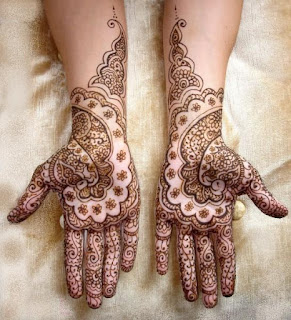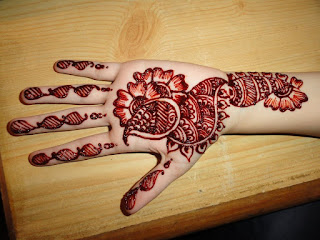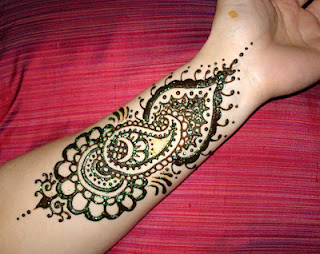 Mehndi or henna is a paste that is bought in a cone-shaped tube and is made into designs for men and women. Mehndi is derived from the Sanskrit word mendhikā. The use of mehndi and turmeric is described in the earliest Hindu Vedic ritual books. It was originally used for only women's palms and sometimes for men, but as time progressed, it was more natural for women to wear it. Haldi (staining oneself with turmeric paste) as well as mehndi are Vedic customs, intended to be a symbolic representation of the outer and the inner sun. Vedic customs are centered on the idea of "awakening the inner light". Traditional Indian designs are representations of the sun on the palm, which, in this context, is intended to represent the hands and feet.
Mehndi or henna is a paste that is bought in a cone-shaped tube and is made into designs for men and women. Mehndi is derived from the Sanskrit word mendhikā. The use of mehndi and turmeric is described in the earliest Hindu Vedic ritual books. It was originally used for only women's palms and sometimes for men, but as time progressed, it was more natural for women to wear it. Haldi (staining oneself with turmeric paste) as well as mehndi are Vedic customs, intended to be a symbolic representation of the outer and the inner sun. Vedic customs are centered on the idea of "awakening the inner light". Traditional Indian designs are representations of the sun on the palm, which, in this context, is intended to represent the hands and feet.
There are many variations and types in mehendi designs which are categorized, such as Arabic mehndi designs, Indian mehndi designs, and Pakistani mehndi designs. Women usually apply variations of henna or mehndi design patterns on their hands and feet.
Health effects
Henna is known to be dangerous to people with glucose-6-phosphate dehydrogenase deficiency (G6PD deficiency), which is more common in males than females. Infants and children of particular ethnic groups, mainly from the Middle East and North Africa, are especially vulnerable. Though user accounts cite few other negative effects of natural henna paste, save for occasional allergic reactions, pre-mixed henna body art pastes may have ingredients added to darken stain, or to alter stain color. The health risks involved in pre-mixed paste can be significant. The United States Food and Drug Administration(FDA) does consider these risks to be adulterants and therefore illegal for use on skin. Some pastes have been noted to include: silver nitrate, carmine, pyrogallol, disperse orange dye, and chromium. These have been found to cause allergic reactions, chronic inflammatory reactions, or late-onset allergic reactions to hairdressing products and textile dyes.
Varieties
 Natural henna
Natural henna
Natural henna stains only a rich red brown. Products sold as "black henna" or "neutral henna" do not contain henna, but are instead made from other plants, or from other substances altogether.
Neutral henna
Neutral henna does not change the color of hair. This is not henna powder; it is usually the powder of the plant Senna italica (often referred to by the synonym Cassia obovata) or closely related Cassia and Senna species.
 |


Post a Comment